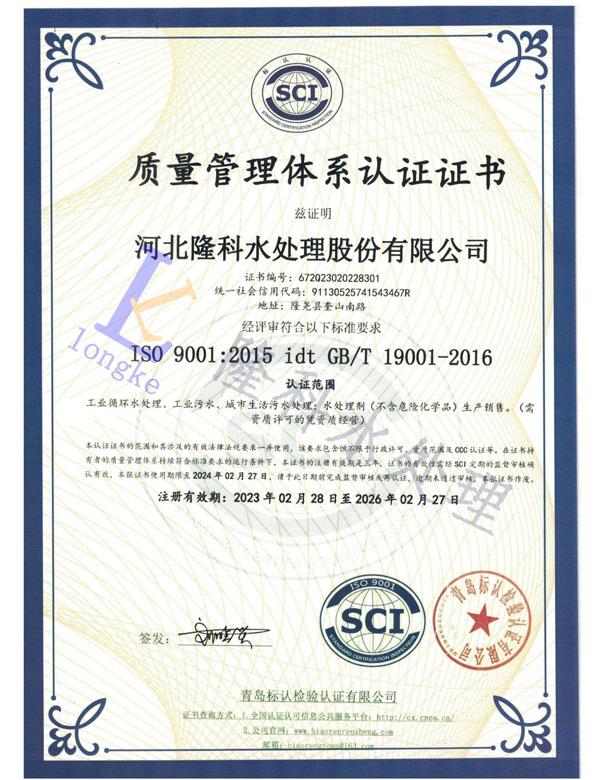coagulation flocculation
Coagulation and Flocculation Key Processes in Water Treatment
Coagulation and flocculation are crucial processes in the field of water treatment, playing a significant role in purifying drinking water and treating wastewater. These processes involve the aggregation of particles suspended in water, making it possible to remove them effectively. Understanding the mechanisms, applications, and benefits of coagulation and flocculation is essential for ensuring clean water supply and maintaining environmental health.
The Mechanism of Coagulation
Coagulation is the first step in the water treatment process. During coagulation, chemical coagulants, such as aluminum sulfate (alum) or ferric chloride, are added to the water. These substances neutralize the electric charges on suspended particles, which typically repel each other due to their similar charges. When these charges are neutralized, particles can begin to stick together, forming larger aggregates known as flocs.
The process is influenced by several factors, including pH, temperature, and the type of coagulant used. Operators must monitor these parameters closely to optimize coagulation efficiency. For instance, pH levels can significantly affect the solubility of coagulants and their efficacy, making it crucial to maintain optimal conditions for maximum performance.
The Role of Flocculation
After coagulation, the water undergoes flocculation. This process involves gently mixing the water to promote the growth of flocs by increasing the contact between the newly formed particles. The goal of flocculation is to create larger aggregates that can be easily removed during subsequent filtration or sedimentation processes.
Flocculation typically occurs in stages, involving slow stirring or mixing to allow the flocs to collide and bond together. The size and density of the flocs are crucial; larger, denser flocs settle more easily, facilitating further removal processes. Additionally, flocculation aids in the removal of impurities such as colloids, dirt, and microorganisms, contributing further to water clarity and quality.
coagulation flocculation

Applications in Water Treatment
Coagulation and flocculation are widely applied in various water treatment facilities worldwide, from municipal drinking water plants to industrial wastewater treatment plants. The efficiency of these processes has implications for public health, environmental protection, and regulatory compliance.
In drinking water treatment, coagulation and flocculation help remove turbidity, color, and pathogens. By reducing these contaminants, the processes ensure that the water is safe for consumption. Similarly, in wastewater treatment, these processes are utilized to eliminate suspended solids and harmful substances before the water is discharged back into the environment.
Benefits of Coagulation and Flocculation
The benefits of coagulation and flocculation extend beyond just improving water quality. These processes can significantly reduce the costs associated with water treatment. By effectively removing suspended particles, the need for extensive filtration systems is diminished, resulting in lower operational costs.
Furthermore, the reduction of pollutants in treated water contributes to environmental sustainability. Clean water discharges into natural water bodies prevent the deterioration of aquatic ecosystems, safeguarding biodiversity and promoting a healthy environment.
Conclusion
Coagulation and flocculation are fundamental processes in the realm of water treatment, vital for ensuring the delivery of safe and clean drinking water as well as the effective treatment of wastewater. By understanding these mechanisms, water treatment facilities can enhance their operational efficiency, reduce costs, and contribute to environmental sustainability. As global water demands continue to rise, the significance of these processes will only grow, highlighting the need for ongoing research and innovation in the field of water quality management.
-
Understanding Polycarboxylic Acids: Properties, Applications, and Future PotentialNewsJul.28,2025
-
Scale Inhibitor Explained: How to Protect Your System from Limescale and Hard Water DamageNewsJul.28,2025
-
Scale and Corrosion Inhibitors: Essential Chemicals for Industrial Water System ProtectionNewsJul.28,2025
-
Polyaspartic Acid: A Biodegradable Polymer for Sustainable ChemistryNewsJul.28,2025
-
Isothiazolinones: A Versatile Antimicrobial Class with Industrial Power and Regulatory ChallengesNewsJul.28,2025
-
A Deep Dive into 2-Phosphonobutane-1,2,4-Tricarboxylic Acid (PBTC)NewsJul.28,2025





